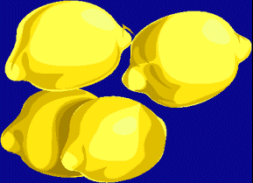A Sour Taste in Your Mouth
Researchers may have pinpointed how the tongue's cells detect sour tastes.
By Emily Sohn
Think of all the amazing things that your tongue does for you. Specialized cells on your tongue, for example, give you the power to enjoy (and gag at) the spices and other flavors of the world’s cuisines.
For years, scientists have been investigating the cells that allow us to detect five distinct tastes: salty, sweet, bitter, sour, and umami. Umami describes the taste of a substance called monosodium glutamate (MSG). So far, sweet, bitter, and umami are pretty well understood. The other two have remained mysterious.
 |
|
How does your tongue detect the sour taste of a lemon? |
Now, at long last, researchers may have discovered the secret behind the puckering flavor of lemons, vinegar, and sour gummy candy. One protein, called PKD2L1, might do the trick.
To decode the sour system, the scientists started by assuming that sour-sensing proteins would share basic traits with proteins that allow us to sense other tastes. In general, these molecules, called receptors, are embedded inside certain tongue cells.
Also, each tongue cell contains a receptor that senses just one type of flavor. One cell might have a sweet receptor, for instance, while another cell responds only to bitter flavors.
The scientists zeroed in on PKD2L1. This protein caught their eye because it appeared to be a specialized protein in taste bud cells. At the same time, it did not show up in cells that sensed sweet, bitter, or umami flavors.
The researchers then created a strain of mice that did not make the PKD2L1 protein. Tests of the animals’ nerves showed that the mice continued to respond to all flavors except sour ones. When the scientists gave them sour chemicals, such as citric acid or vinegar, nothing happened.
The mice “were completely insensitive, just like we were dabbing their tongues with water,” says research-team leader Charles S. Zuker of the University of California, San Diego.
The discovery may eventually help chemists make foods more or less sour, from the inside out.
Here’s what I’d like to know next: Why do some people like to eat sour candy? I’m not a fan, and I never will be, but I know people who love it. The mysteries of science never cease to amaze me!—E. Sohn
Going Deeper:
Brownlee, Christen. 2006. Sweet finding: Researchers propose candidate sour sensor. Science News 170(Aug. 26):132-133. Available at http://www.sciencenews.org/articles/20060826/fob4.asp .
To learn more about taste and how the tongue detects flavors, go to faculty.washington.edu/chudler/tasty.html (Neuroscience for Kids).
Sohn, Emily. 2005. Taste messenger. Science News for Kids (Dec. 7). Available at http://www.sciencenewsforkids.org/articles/20051207/Note3.asp .
Science project ideas from the LabZone:
Totally Tasteless: Try to taste the difference between foods while holding your nose.
http://www.sciencenewsforkids.org/articles/20060315/LZActivity.asp
Bad Taste Genes: Use orange juice to see if you’ve inherited a sensitivity to bitter taste.
http://www.sciencenewsforkids.org/articles/20060215/LZActivity.asp
The Taste Test: Find four different taste areas of the tongue.
http://www.sciencenewsforkids.org/articles/20030910/LZActivity.asp
For additional activities and experiments involving taste, go to faculty.washington.edu/chudler/chtaste.html (Neuroscience for Kids).
For information about mapping taste areas on your tongue, see pbskids.org/zoom/activities/sci/tonguemap.html (PBS).







